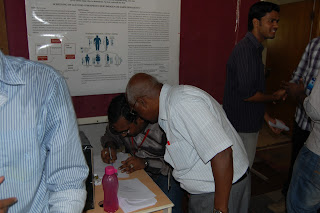Screening of Glucose 6 Phosphate Dehydrogenase (g6pd) Deficiency on september 6th and 7th 2012 in Bioengineering Block.
G6PD – The Enzyme:
G6PD is a highly conserved housekeeping enzyme that performs vital functions, especially prevention of oxidative stress, within all cells of the body. It is particulary essential and important within the RBCs that lack a nucleus, mitochondria, and other cellular organelles and thereby, not able to synthesize new proteins and compensate for poor G6PD function. It protects RBCs from certain substances that are harmful to the body. The role of the enzyme is to produce NADPH, a factor that helps glutathione to fight against free radicals and thereby protect the cells from oxidative stress and damage.
G6PD Genetics
In humans, G6PD gene is located on the telomeric region of the long arm of the X-chromosome. Females have two X chromosomes, hence two copies of G6PD, while males have only one X-chromosome and one copy of G6PD. In other words, G6PD is an X-Linked recessive condition which means that males are more susceptible to complications driven by G6PD deficiency than are the females.
G6PD Deficiency and Symptoms:
G6PD deficiency is the most common known enzyme deficiency in humans. G6PD deficiency is an X-chromosomally transmitted disorder of the erythrocyte that affects approximately 400 million people worldwide and has about 300 variants.

G6PD deficiency causes increased susceptibility of erythrocytes to H2O2 and other reactive oxygen species that can lead to haemolytic anemia, favism, chronic non-spherocytic hemolysis, spontaneous abortions, and neonatal hyperbilirubinemia resulting in neonatal kernicterus. G6PD deficiency is mainly found in areas where malaria is or has been endemic. G6PD deficiency can neither be prevented nor provoked. However, the symptoms of G6PD deficiency can be triggered by certain medicine, foods, and substances.G6PD deficiency can be serious if it is not diagnosed. Symptoms include (1) G6PD deficiency is manifested as anemia, with RBCs being prematurely destroyed - RBCs are also extremely susceptible to oxidative stress; (2) Neonatal jaundice is a yellowish discoloration of the whites of the eyes, skin, and mucous membranes caused by deposition of bile salts in these tissues - A severe form of this is a direct result of insufficient activity of the G6PD enzyme in the liver; (3) Viral hepatitis, pneumonia, and typhoid fever are likely to precipitate a hemolytic episode in G6PD deficient cases.
Importance of screening for G6PD activity
India is endemic for malaria and antimalarial drugs are routinely prescribed for most cases. This treatment can induce oxidative stress to the cells and, in turn, cause severe hemolysis in G6PD deficient patients. Therefore, screening patients for G6PD deficiency before treatment with potential hemolytic agents becomes necessary. In conclusion, screening allows patients to educate themselves about a condition that will affect them and helps to avoid triggering substances and situations. Thus the results of this test will help to create awareness about G6PD deficiency in the society.
India is endemic for malaria and antimalarial drugs are routinely prescribed for most cases. This treatment can induce oxidative stress to the cells and, in turn, cause severe hemolysis in G6PD deficient patients. Therefore, screening patients for G6PD deficiency before treatment with potential hemolytic agents becomes necessary. In conclusion, screening allows patients to educate themselves about a condition that will affect them and helps to avoid triggering substances and situations. Thus the results of this test will help to create awareness about G6PD deficiency in the society.
Organised by
Dr. M. Parani
Mr. N. Manoj Kumar
Volunteers - M.Tech II Year - Prasanna, Shwetha, Amudhavani.
M.Tech I Year - Dilip & Kevin Kumar
B.Tech IV Year - Deepanjan
B.Tech III Year - Monisha & Mohith
Volunteers - M.Tech II Year - Prasanna, Shwetha, Amudhavani.
M.Tech I Year - Dilip & Kevin Kumar
B.Tech IV Year - Deepanjan
B.Tech III Year - Monisha & Mohith







